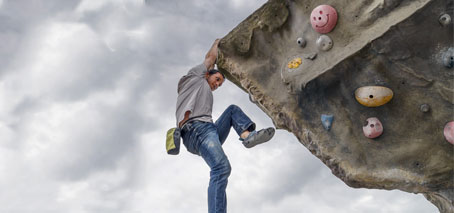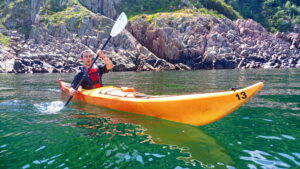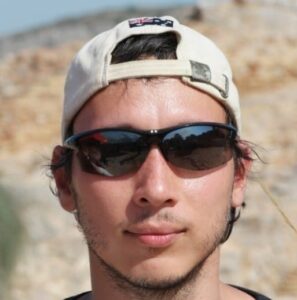
Ex FLEET/Swinburne PhD student Pavel Kolesnichenko is now a senior postdoctoral scientist at Heidelberg Uni in Germany.
Ex FLEET/Swinburne PhD student
Now senior postdoctoral scientist at Heidelberg University (Germany)
Hello FLEETers! I am Pavel. I completed my Ph.D. at FLEET, working with Prof. Jeffrey Davis at Swinburne University of Technology (Centre for Quantum and Optical Science).
Actually, if your own work at FLEET includes optical characterisation of 2D semiconductors, you might even be using something I built!
These days I’m at Heidelberg University in Germany, applying expertise gained at FLEET on 2D materials and spectroscopy, and putting other ‘soft’ FLEET skills to use too, such as communication.
The ‘big picture’ of my research in Sweden aligns well with what we worked together on at FLEET: contributing to minimizing the impact of global warming and reducing material and energy waste.
Q: Tell us more about Heidelberg Uni. What do you do now?
After completing my Ph.D. and leaving Australia, I continued work in academia as a postdoctoral researcher. First, as a junior postdoctoral researcher at Lund University in Sweden, and now as a senior postdoctoral scientist at Heidelberg University in Germany.
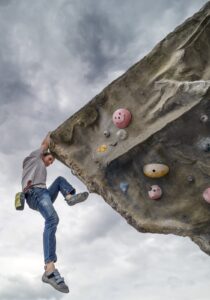
“Look after your mental health. Do the things that bring you joy.” (In this case, climbing in Sweden). Photo credit: Dmitry Dzhigaev (@dzheyphotography)
At Lund University I became a member of another organization called NanoLund. Having applied my writing skills gained at FLEET, I managed to win a NanoLund junior scientist ideas award for the project related to the development of neural networks for spectroscopic applications.
I have also continued studying 2D materials and developing hard-core spectroscopic tools for studying surfaces and nanomaterials. At Lund Uni, I was involved in the development of a time- and energy-resolved photoemission electron microscope, which I then applied to study spatially-resolved carrier dynamics in 2D materials as well as nanowires and semiconducting surfaces.
In Germany, I continued my research activities in the direction of developing customized spectroscopy setups for their applications to solid-state nanomaterials.
Currently, together with a junior Ph.D. student Oskar Kefer, we are developing a 2D electronic spectroscopy setup for studying solid-state nanomaterials including 2D materials. Meanwhile, I am investigating exciton-polariton microcavities with the goal of improving the photoconversion efficiency of photovoltaic devices.
I greatly enjoy having a project based on my previous experience and being able to provide a good level of consultancy. I also enjoy learning new things, which further boosts my motivation and confidence.
For example, I have developed better diplomatic skills when it comes to collaborations and convincing people. One of the new skills I acquired and developed after my Ph.D. is the skill of balancing work and life.
Even when progressing your career, I think it’s really important not to compromise your social life and friendships. At the end of the day, having real friends across your life and amazing memories are one of the most important assets one can obtain.
I feel that the balance between life, work, and mental health rarely comes naturally in academics, and one should really put an effort and keep doing so to attract this balance. And, once having achieved that balance, protect it. Be proactive and keep going out to socialise and indulge the things that bring you joy (eg, cycling, climbing, and surfing; hiking; dinner at restaurants), or become a member of a club that matches your own interests.
Q: What did you do at FLEET? And what’s this technique of yours I might want to use?!
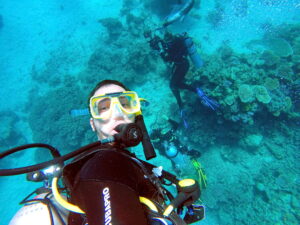
“Keeping work-life balance can sometimes be challenging, but there are many options, for example, diving, climbing, etc., which are also a great source for socializing with a broad range of people outside science” Diving on the Great Barrier Reef…
I studied exciton-related optical properties of 2D semiconducting materials such as monolayers of tungsten and molybdenum disulphides (WS2, MoS2), and how these properties are affected by the spatially distributed disorder, doping, and strain.
At Swinburne, I built a bi-modal scanning micro-spectroscopy setup that allows measurement of absorption and photoluminescence spectra across monolayers with nearly diffraction-limited resolution (~300 nm), which is now available for all FLEET members for use on demand.
Using this setup, I developed an approach for all-optical characterization of 2D semiconductors, in which unsupervised machine-learning algorithms would separate spatially heterogeneous areas on monolayers affected by doping, strain, and disorder. (Read more on the FLEET blog.)
I also developed an approach for coherent Raman spectroscopy using our laboratory’s existing 2D electronic spectroscopy techniques. The approach reduced to combining coherent Stokes Raman spectroscopy (CSRS) and coherent anti-Stokes Raman spectroscopy (CARS) and implementing a one-click switch between the two without having a need to realign the setup. This was achieved by using pulse shaping via a spatial light modulator and proved to be useful, for example, in separating quantum excitations on the excited electronic state from those on the ground electronic state.
Q: What did you enjoy about your job at FLEET?
Socialising, traveling, and learning new things!
Being a FLEET member gave me lots of opportunities to meet many interesting people. FLEET done a great job in bringing scientists from different nodes and external institutions together. So I attended FLEET events such as conferences, summer schools, and workshops at different sites of Australia and outside (frequently close to some nature gems for stimulating creativity and open-mindedness).
To mention just a few, I learned a lot about topological phases of matter from attending the Gordon Research Conference in Hong-Kong, and a summer school in Canberra; how to write better abstracts at the workshop by a Nature Physics chief editor Luke Fleet given within one of the FLEET’s annual meetings in Sydney, and how to write better grants in the Ideas Factory event.
I always enjoyed talking to people, exploring places and having fun together, and often getting captivated by new ideas that were popping up here and there.
Q: How has your FLEET/Swinburne training help in your current job?
Being part of FLEET greatly contributed to widening my horizons – scientifically and opportunities-wise.
With that training, I am not as hesitant anymore to embark on a completely new research direction, and I’m more confident about my own expertise and knowledge.
Amongst the specific skills I gained, as I mentioned above, are communications skills (also thanks greatly to Dr. Stuart Earl who looked through my thesis and made lots of useful comments) that I used to win the NanoLund grant and to communicate research in a clear way via publications and presentations.
Not to mention other professional skills such as experimental skills giving me confidence in myself and belief in my abilities to conduct projects independently.
Q: How’d you get the jobs at Lund and Heidelberg?
Getting a postdoc job in academic research is always a challenge, considering how many new PhDs are released each year compared to how few there are new position openings available.
Networking and good recommendations from colleagues and supervisors played a decisive role in my case.
Needless to say, your CV, cover letter, and professional social profile have to be polished as well – at least to get to the interview stage. For the interview itself, it is important to be prepared in advance; and at the interview keep cool, be confident, and be honest.
Tell us about your path from animation to physics. How’d you get into science?
My story is funny. When I was at school, I had a hobby of 3D modelling and 3D animation, and at some point, I started thinking about how one could realistically animate physical processes, such as turbulent fluid-flow or flag-waving.
So, I thought I had to study a bit of physics to understand the tricks behind such animations, and I went to study physics at university.
Soon after, I realised that one does not have to know physics almost at all to be able to animate the mentioned processes (although those who do have some advantages there as well).
But I’ve never regretted my choice. Studying physics and mathematics (and many other sciences) helped me develop my main skill, which is the skill to learn, grasp new knowledge quickly, and immediately apply it.
FLEET alumni
FLEET is developing a skilled workforce of future Australian science leaders. We are extremely proud of those members who have already moved on to great careers, making use of skills developed in their time at FLEET. Ultimately it will be FLEET alums as much as research outputs that define the success of the Centre. Read more alumni news at FLEET.org.au/alumni

